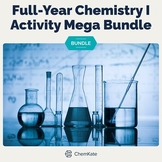Free: Periodic Table of Elements Color by Category | print and digital
- PDF
Also included in
- This is a custom bundle, but you may purchase this custom bundle for yourself or request your own by emailing KateCk@ChemKate.com. Deeper discounts, anywhere from 20-30% off, are given based on the price range, email me for details.This custom bundle includes a sampling of year-long resources includPrice $142.77Original Price $178.46Save $35.69
- Teaching chemistry? Looking for a wide variety of engaging, low- to no-prep, digital, and easy-to-use activities to help you teach chemistry and your curriculum? Save 30% with this full year Chemistry I Activity Mega Bundle includes full of self-grading, self-checking activities, inquiry activities,Price $337.85Original Price $482.64Save $144.79
- Look for activities and resources to teach the Periodic Table of Elements to simplify your lesson planning and keep your students engaged? A wide variety can be found in this cost-savings bundle. The activities and resources range covers the topics of an element to symbol recognition, placement on tPrice $11.93Original Price $13.25Save $1.32
Description
This no-prep Periodic Table chemistry activity, in print and digital, engages students with labeling the categories of the periodic table. These easy-to-read Periodic Tables are current with a full 7th period and groups labels 1-18. Choose between a Google Slides version or printable PDF that can be used as an assessment tool a group assignment, a homework assignment, or for early finishers. Blank periodic table references full and half-size are also included!
✦ Save 20% with this and easy, engaging labs in the Periodic Table of Elements Activity Bundle or save 30% , gain ease and assurance with this and activities such as interactive particle diagrams, stations, and self-grading practice in the Full-Year Chemistry I Activities Mega Bundle ✦
At the end of this PDF, are blank periodic tables with or without names. After this assignment, students will have an electronic and/or a hard copy of the periodic table to reference all year long.
Categories include: Alkali metals, alkaline earth metals, transition metals, metalloids, halogens, noble gases, lanthanides, actinides, other metals (groups 13-16), and other nonmetals (groups 14-16)
Interested in more?
Mole and Stoichiometry Resources
● Be sure to follow my store to be alerted of new products: CLICK HERE
● Did you know that you can receive credit for reviewing purchased product? Your feedback goes a long way. It helps people find this resource and is important to me as I consider future resources, and lets me know that I'm helping to support and serve you. Leave a review here or through "My Purchases" under "My Account". If you have any other questions or comments, please contact me at KateCk@chemkate.com or in the "Q&A" tab above.







